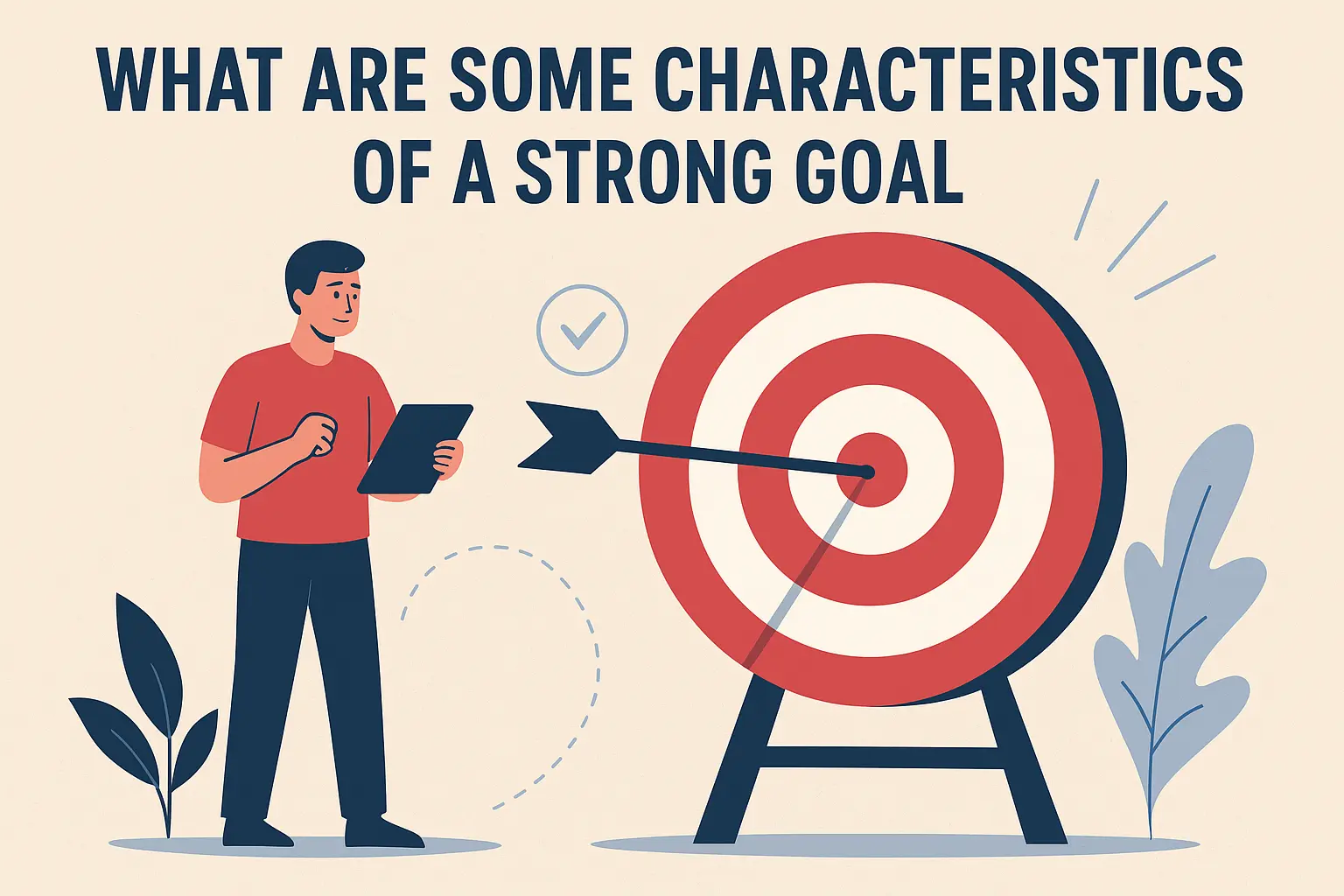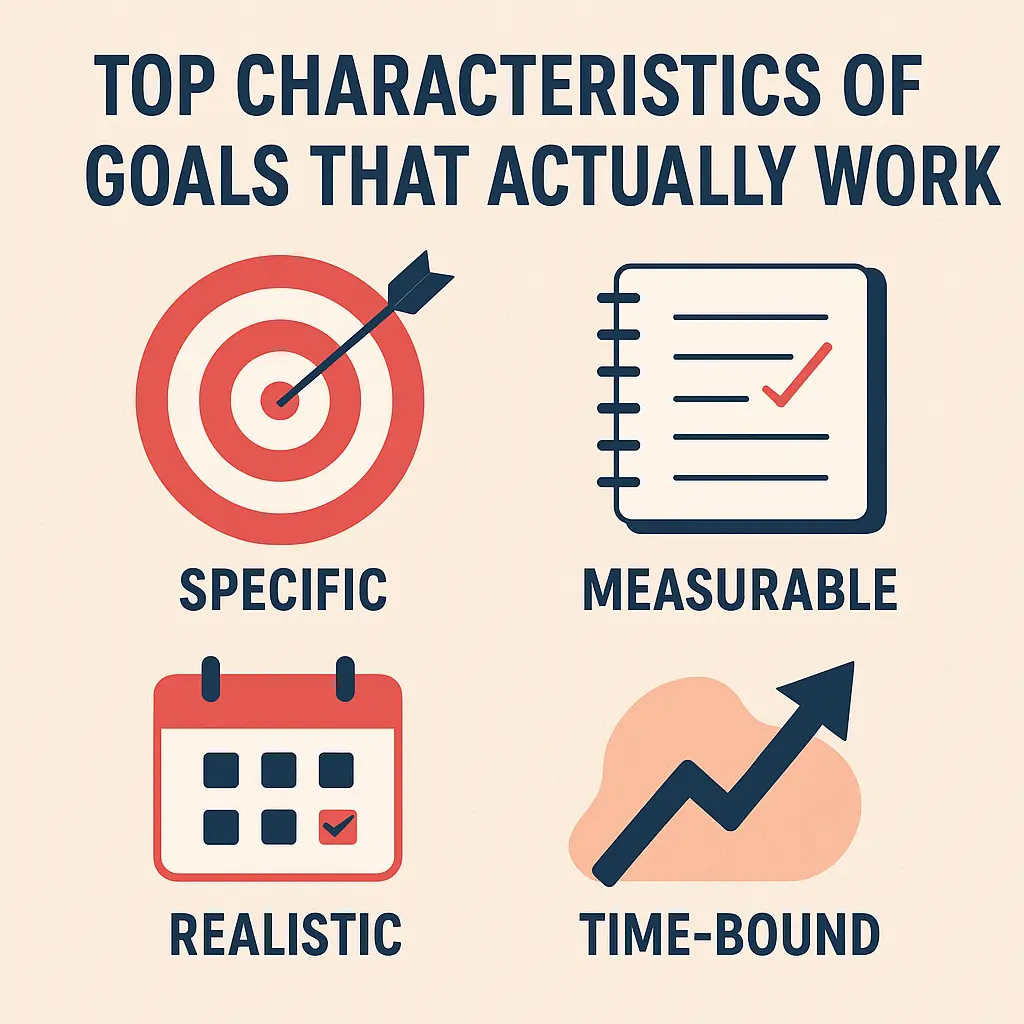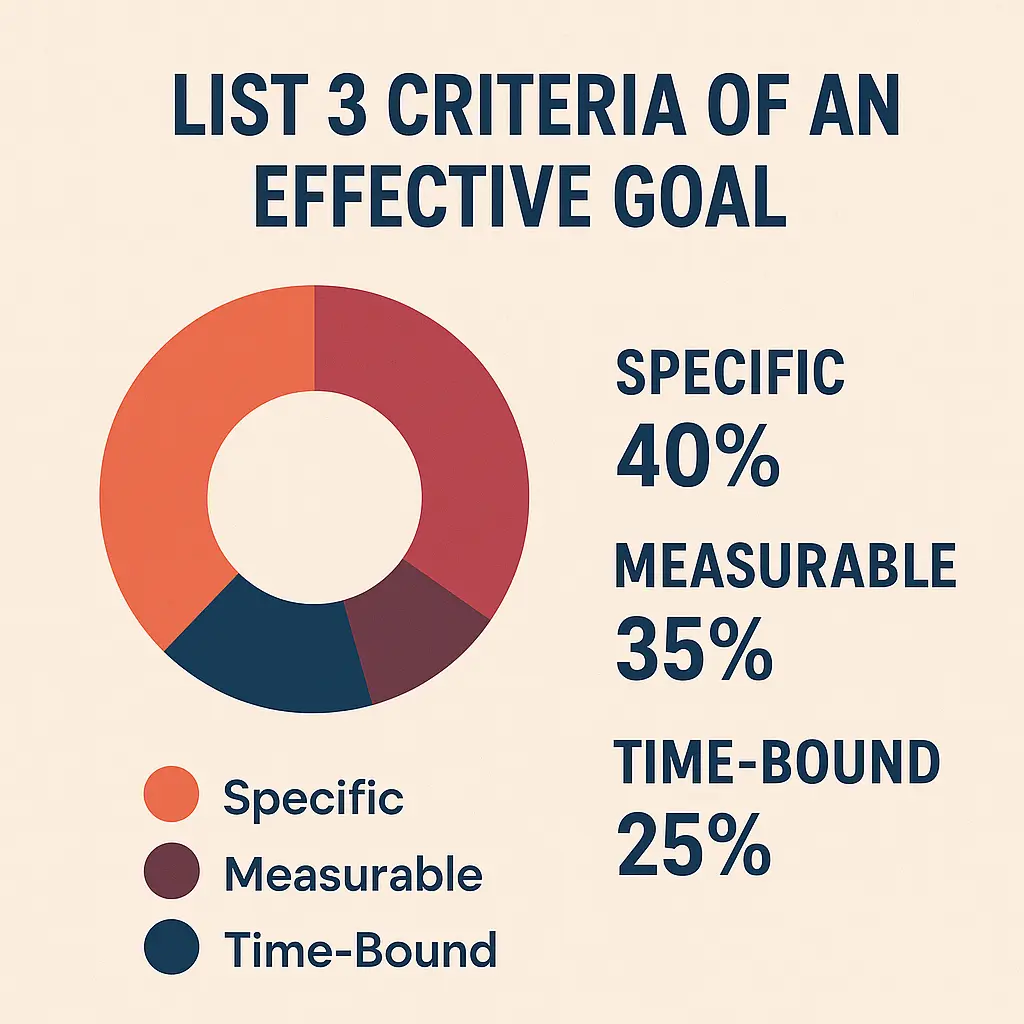What Are Some Characteristics of a Strong Goal? Clear Traits

What are some characteristics of a strong goal? It’s not just about writing something down and hoping for the best. Strong goals have structure. They’re built with purpose, not guesswork. The best ones guide action, measure progress, and lead to real outcomes—not just ideas floating in your head.
If your goals keep getting pushed to the side or feel out of reach, the problem usually isn’t your ambition—it’s the way the goal is built. A strong goal acts like a map. It gives direction, keeps you moving, and shows you when you’re off track. Instead of leaving things open-ended, it brings clarity, accountability, and motivation all in one.
|
Goal Trait |
Strong Goal |
Weak Goal |
|---|---|---|
|
Clarity |
Clear and direct (e.g., lose 5 lbs in 30 days) |
Vague or general (e.g., get healthy) |
|
Measurability |
Progress can be tracked |
No way to measure improvement |
|
Realism |
Fits current resources and timeline |
Unrealistic or too easy |
|
Purpose |
Tied to a personal reason or need |
No clear reason or emotional link |
|
Timing |
Has a deadline or schedule |
Open-ended or “someday” goal |
What Makes a Good Goal?
A good goal isn’t something you set just to feel productive. It’s built with purpose and clarity. It moves beyond vague ideas like “be better” or “do more.” Instead, it gives you something you can act on, track, and achieve step by step.
So, what makes a good goal? It’s specific enough to remove guesswork. It’s flexible enough to adjust, but steady enough to stay focused. And above all, it connects directly to something that matters to you—personally, professionally, or both.
Let’s break it down further.
Focus
Strong goals are focused. They don’t try to fix five things at once or chase too many targets. Instead, they lock onto one clear outcome.
Trying to “get in shape” is vague. A focused version would be, “Walk 30 minutes five times a week.” See the difference? Focus keeps your mind clear. It eliminates the side distractions that make progress harder than it has to be.
When goals lack focus, motivation fizzles. You don’t know where to start, so you start nowhere. But when focus is tight, it becomes easier to make time, stay consistent, and see progress.
Direction
Goals give direction. Without one, you’re basically walking without a map. You might be moving—but not necessarily forward.
Let’s say you want to grow your career. A goal like “learn a new job skill within two months” gives a straight path. You can plan what to learn, how to learn it, and when to use it. That’s what direction does—it turns ideas into steps.
People lose time chasing vague outcomes because they never built a path. Strong goals point you somewhere specific, and once that direction is clear, every action feels more meaningful.
Real-World Value
A strong goal isn’t just good on paper—it matters in real life. That means it connects to something that improves your health, your work, your relationships, or your overall well-being.
Ask yourself, “What difference will this make?” Goals that carry value are easier to stick with. You’ll care more. You’ll protect time for them. And you won’t toss them aside the moment things get busy.
Real-world value also helps you filter out goals that sound good but do nothing. Not every goal is worth chasing. But when one improves your day, your energy, or your future, it’s the kind that lasts.

Top Characteristics of a Strong Goal That Actually Work
Not every goal is strong, and that’s where most people get stuck. They start with good intentions, but their goals have no legs—no direction, no details, no system to move forward. What actually works are goals built with structure. You know exactly what you’re working toward, and you don’t waste time wondering what comes next.
The strongest goals share a few traits that make them easier to follow, easier to track, and far more likely to succeed. Let’s walk through them one by one—these aren’t theories. These are what real, workable goals are made of.
1. Clear and Specific
If your goal sounds like a wish, it’s probably too vague. Saying “I want to be better at saving” doesn’t give your brain much to act on. But saying “Save $100 from each paycheck for the next three months” gives clarity. Now your brain has a job.
A specific goal answers three questions:
– What do I want to do?
– How will I do it?
– What result do I expect?
Once those are covered, excuses drop. There’s no second-guessing or rethinking—it’s all right in front of you.
2. Measurable
If you can’t measure it, how do you know it’s working? Measurable goals give you checkpoints. You don’t have to guess if you’re improving—you can see it.
Instead of “I want to lose weight,” try “I want to lose 5 pounds in 30 days.” That’s a number. It’s clear. It’s something you can track every week.
Measurement also gives momentum. Every time you move one step closer, you feel it. That’s how people stay motivated—it’s not just the end result; it’s knowing you’re actually making progress.
3. Achievable and Realistic
Goals aren’t dreams. They’re targets you can actually hit. That’s why being realistic matters more than being ambitious. If a goal feels too far away, you won’t even start. But if it feels within reach, your mind is more likely to commit.
This doesn’t mean aiming small. It means aiming smart. For example, starting a side business in six months is ambitious—but possible with planning. Earning a million dollars by next month when you’re starting from scratch? Not so much.
The more your goal fits your current resources, time, and skill, the more likely you are to follow through.
4. Time-bound
Without a time limit, most goals stretch forever. There’s no pressure, no urgency—and that means no real progress. A strong goal has a deadline. It’s not always harsh or rigid, but it’s there.
Saying “I’ll finish my certification course this year” is better than just “I’ll do it someday.” The deadline creates structure. You can reverse-plan from it, break things into tasks, and hold yourself accountable.
Time puts action on the calendar—and that’s what moves a goal from “idea” to “done.”
5. Relevant to Your Purpose
Goals should feel connected to something real in your life. If they don’t matter to you, they won’t last. People give up on goals that feel like chores. But they stick with ones that reflect something they care about.
Let’s say you want to improve your fitness. If your deeper reason is “I want to keep up with my kids,” then suddenly the goal becomes personal. It has weight. That’s the difference between a random challenge and a strong purpose-driven goal.
Ask yourself: Why am I setting this? What part of my life will it change? That clarity adds meaning—and meaning builds commitment.

List 3 Criteria of an Effective Goal
Most goals don’t fail because people are lazy. They fail because the goal wasn’t built right in the first place. It lacked shape, timing, or direction. That’s where structure matters. And if there’s one reliable way to build a strong goal, it starts with three solid criteria: Specific, Measurable, and Time-bound.
These aren’t just buzzwords—they shape the goal into something real. Without them, a goal stays a wish. With them, it becomes a plan.
Specific, Measurable, Time-bound
Let’s break down each of these:
- Specific: Vague goals lead nowhere. Saying “I want to be healthier” sounds nice but doesn’t tell you what to do. A specific version might be, “I’ll walk for 30 minutes every morning.” It names the action clearly.
- Measurable: You need a way to track it. If you can’t measure progress, how do you know you’re moving forward? Instead of “Read more,” say “Read 12 books by the end of the year.” Numbers show progress.
- Time-bound: A goal without a deadline drifts. A time limit makes it real. It doesn’t need to be strict, but it needs to exist. “Finish the course in 60 days” gives structure. It keeps momentum alive.
These three points build a solid core. When in doubt, test your goal against them. If it misses one, it may need adjusting.
Clarity improves follow-through
A psychology study published in the British Journal of Health Psychology found that when people plan their goals using clear “if-then” formats, follow-through rates almost double.
What Are Two Characteristics That Define Goals?
Strip goals down to the basics, and two things make the biggest difference: Clarity and Commitment.
Most people don’t need more ideas—they need clearer ones. And once they have that clarity, they need to back it up with consistent effort. That’s where these two characteristics come in.
Clarity and Commitment
- Clarity: You can’t hit a target you can’t see. Clarity means you know what you’re trying to do and why. It cuts through the noise and focuses your energy. A clear goal isn’t buried under vague words—it’s direct, simple, and leaves no confusion.
- Commitment: Clarity gives direction, but commitment moves the feet. Goals require consistency. Showing up when you don’t feel like it. Sticking with the plan when the results aren’t instant. Without commitment, even the best plans fall flat.
Think of clarity as the map—and commitment as the fuel. You need both to get anywhere meaningful.
Why Vague Goals Fail
A lot of goals sound good but go nowhere. That’s because they’re too loose. Vague goals don’t tell you what to do, when to do it, or what success looks like. You start with energy, then stall because nothing about the goal gives real direction.
Take something like “I want to get in shape.” It sounds like a goal, but it’s missing the essentials. What does “in shape” mean? How will you track it? When should it happen? Without details, your mind doesn’t know what steps to take. It becomes easy to delay, forget, or keep restarting.
Strong goals don’t leave room for confusion. They give you a target and a way to aim at it. Vague goals, on the other hand, leave you walking in circles.

How to Know If a Goal is Too Broad or Too Small
A goal that’s too broad makes you feel overwhelmed. A goal that’s too small doesn’t push you forward. You need that middle ground—something challenging but doable.
Here’s how to spot the difference:
- Too broad: “Improve my life.”
This goal touches everything but solves nothing. There’s no clear path. - Too small: “Drink one glass of water tomorrow.”
It’s helpful—but not enough to create lasting impact.
Ask these quick questions:
- Can I break this goal into smaller steps?
- Does it challenge me without feeling impossible?
- Is the result clear?
If the answer is no, the goal probably needs adjusting. A well-sized goal feels like a stretch—but not a struggle.
Simple Examples of Strong Goals vs Weak Goals
To make this clear, let’s put strong and weak goals side by side. It’s not about using fancy words—it’s about being precise and real.
|
Weak Goal |
Strong Goal |
|---|---|
|
Get healthier |
Walk 30 minutes every morning for the next month |
|
Save money |
Save $200 from each paycheck for 6 months |
|
Be more productive |
Finish two tasks before lunch each workday |
|
Read more |
Read one book every month |
|
Learn a new skill |
Take an online Excel course and finish by Oct 1 |
|
Spend more time with family |
Have dinner with family 4 nights a week |
Strong goals spell out what, how, and when. That’s what makes them work—they don’t leave room for doubt or delay. Weak goals are just intentions. Strong goals are instructions.
Conclusion
Setting goals isn’t just about motivation—it’s about design. When you structure your goals clearly and give them purpose, they stop being hopeful ideas and start becoming real achievements. A strong goal speaks in specifics. It has a start, a finish, and a reason to exist.
If your goals feel heavy, scattered, or slow-moving, it’s not always about your discipline. Sometimes, the goal just isn’t built well enough to carry you forward. So, next time you write one down, ask yourself: Is it clear? Can I track it? Does it matter to me?
Get those right, and you’re already halfway there.

About the Author
Jonathan Savage is a leadership strategist who helps teams boost performance through clarity and structure. At SmartSuccessGuide.com, he shares proven frameworks for building focused, high-performing teams that deliver real results.






